 .
.




Surrounding the above described detectors is a high resolution shower
calorimeter which contains 240 detector modules all of which are made of pure
CsI. Its geometry is spherical with two openings for beam entry and readout of
inner detectors as displayed in figure  .
.
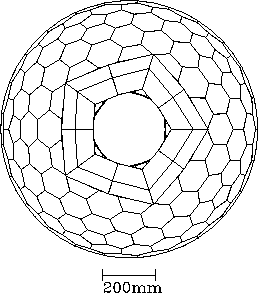
Figure: The pion beta shower calorimeter
and its segmentation as a result of a class II geodesic subdivision of an icosahedron.
It contains 240 modules each of which is read with a photomultiplier tube glued at its
back face. The edge vetoes (20 in total) define the boundary of the openings. There is a
gap of  between modules, a gap filled by the wrapping material around
each detector.
between modules, a gap filled by the wrapping material around
each detector.

Table: Some other properties of
the shower calorimeter.
The solid angle coverage of the calorimeter is about  of
of
 , and its modularity is obtained from a class II geodesic triangulation of
an icosahedron as explained in the next chapter. As a result of the geodesic
breakdown, there are nine distinct modular shapes which make up the
240 detectors: one truncated pentagonal pyramid (P), four different types of
truncated hexagonal pyramids (A, B, C and D) and four different types of
truncated trapezoidal pyramids (HD and VT). The average thickness of a
detector module is 12 radiation lengths (
, and its modularity is obtained from a class II geodesic triangulation of
an icosahedron as explained in the next chapter. As a result of the geodesic
breakdown, there are nine distinct modular shapes which make up the
240 detectors: one truncated pentagonal pyramid (P), four different types of
truncated hexagonal pyramids (A, B, C and D) and four different types of
truncated trapezoidal pyramids (HD and VT). The average thickness of a
detector module is 12 radiation lengths ( ) and the average solid
angle it
subtends is
) and the average solid
angle it
subtends is  . The dimensions of the nine different shapes
have been determined in such a way as to leave a gap of
. The dimensions of the nine different shapes
have been determined in such a way as to leave a gap of  between adjacent modules in the entire calorimeter. However, the gap is not an
air gap. Rather, it accounts for the surface treatment and the wrapping of the
modules.
between adjacent modules in the entire calorimeter. However, the gap is not an
air gap. Rather, it accounts for the surface treatment and the wrapping of the
modules.

Table: Properties of the pentagonal pyramid.
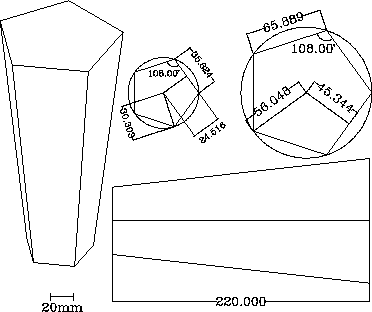
Figure: The truncated pentagonal
pyramid. It is the only regular geometry of the 9 shapes and there are 10 such modules
in the calorimeter.
Each of the modules with pentagonal and hexagonal shapes is viewed by a
3-inch photomultiplier tube (PMT) with quartz window while the other modules
are each readout with a 2-inch PMT also with quartz window, (the spectral
response of CsI peaks in the UV region to which the quartz is transparent).
The PMT are glued to the back faces of the modules with a  layer of silicon elastomer of Sylgard 184. Some parameters of the calorimeter
are cataloged in table
layer of silicon elastomer of Sylgard 184. Some parameters of the calorimeter
are cataloged in table  . The information regarding the
individual modular shapes are compiled in the following tables 5.3-5.11 and
the shapes themselves are also shown in the figures 5.9-5.18.
The dimensions of the modules were submitted (for their fabrication) to the
companies specialized in the growth of CsI. Twenty-five of them were produced
by Bicron corporation while the rest are being made in Kharkov (Ukraine).
. The information regarding the
individual modular shapes are compiled in the following tables 5.3-5.11 and
the shapes themselves are also shown in the figures 5.9-5.18.
The dimensions of the modules were submitted (for their fabrication) to the
companies specialized in the growth of CsI. Twenty-five of them were produced
by Bicron corporation while the rest are being made in Kharkov (Ukraine).
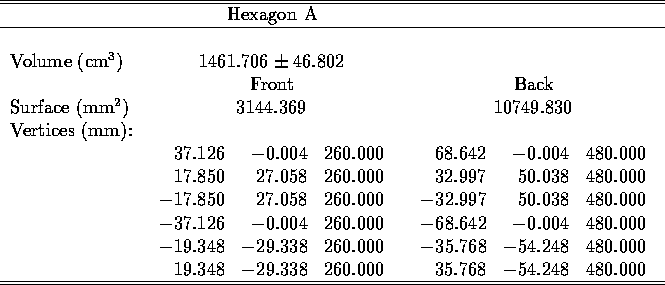
Table: Properties of the hexagonal pyramid A.
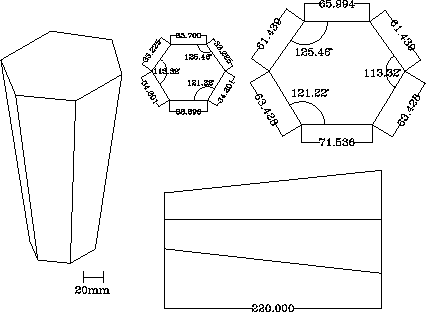
Figure: The truncated hexagonal
pyramid A. There are 50 such modules in the calorimeter. Each pentagon is surrounded on
all its five sides by hexagon A's.

Table: Properties of the hexagonal pyramid B.
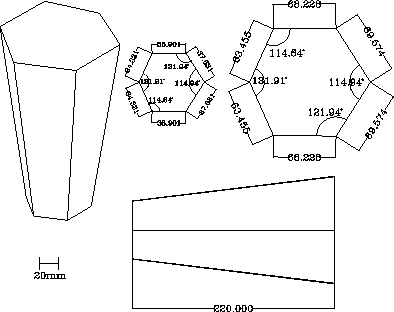
Figure: The truncated hexagonal
pyramid B. There are also 50 hexagon B in the calorimeter.

Table: Properties of the hexagonal pyramid C.

Figure: The truncated hexagonal
pyramid C. The calorimeter contains 50 hexagon C.
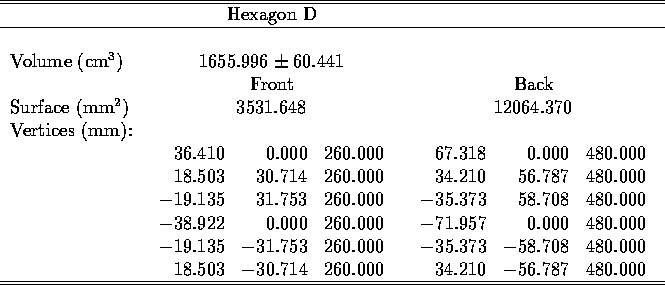
Table: Properties of the hexagonal pyramid D.

Figure: The truncated hexagonal
pyramid D. There are 40 hexagon D in the calorimeter instead of 50 as the other types
of hexagonal pyramids.

Table: Properties of the trapezoidal
pyramid HD1.

Figure: The truncated
trapezoidal pyramid HD1. There are 10 of these modules in the calorimeter. In the
original geodesic breakdown, this shape and its mirror symmetry HD2 generate the
hexagonal pyramid D. As a result, they have been named HD for Half hexagon D. In
the limit of zero gap between modules in the calorimeter, HD1 and HD2 would perfectly
reproduce the hexagon D.

Table: Properties of the trapezoidal
pyramid HD2.
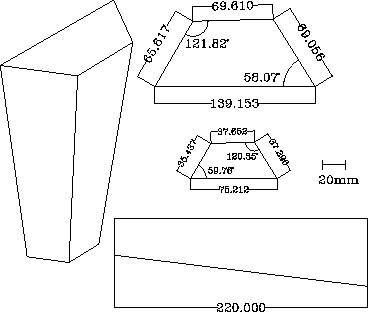
Figure: The truncated trapezoidal
pyramid HD2. The calorimeter contains 10 of them and the are the mirror symmetry of the
HD1's.



